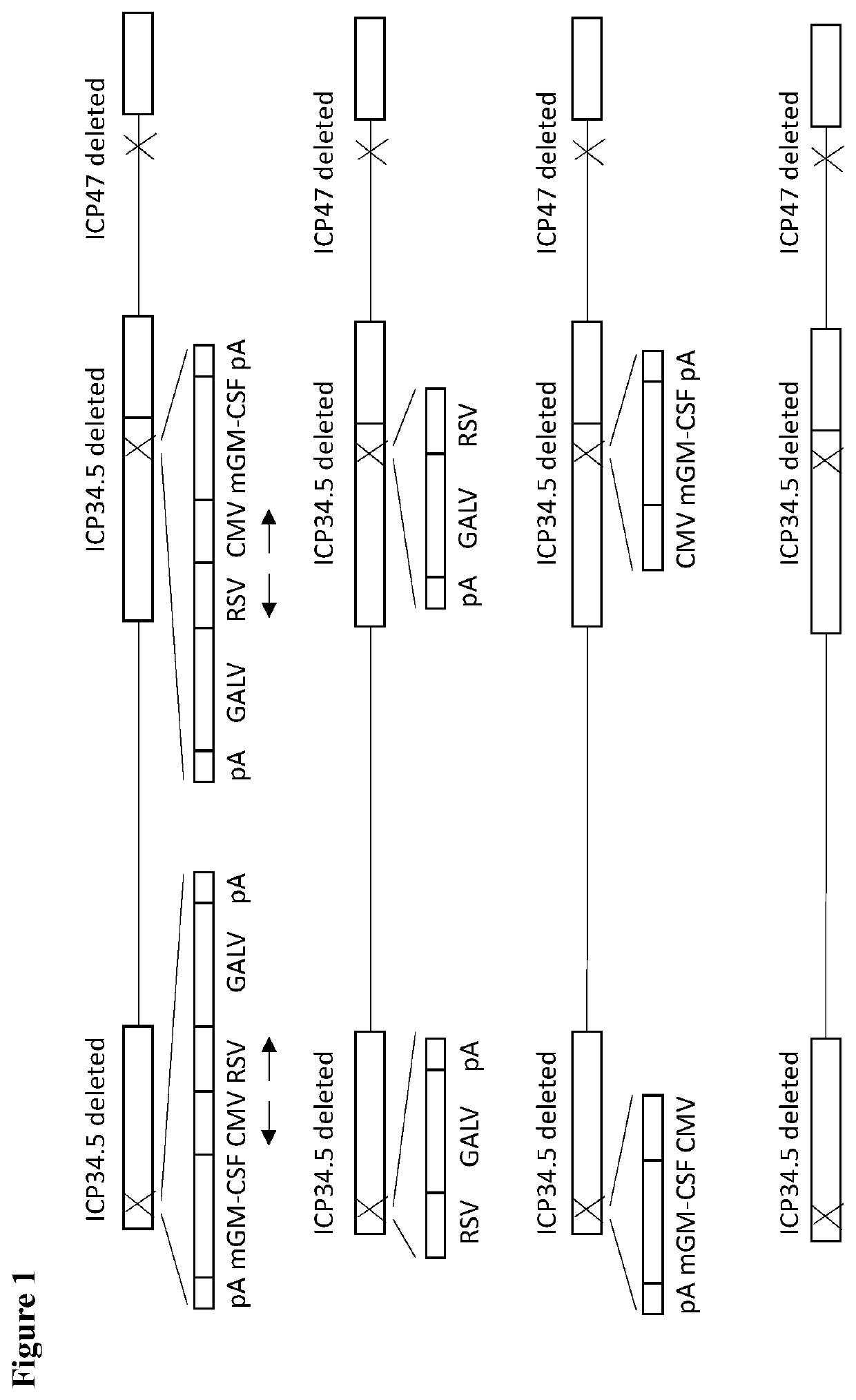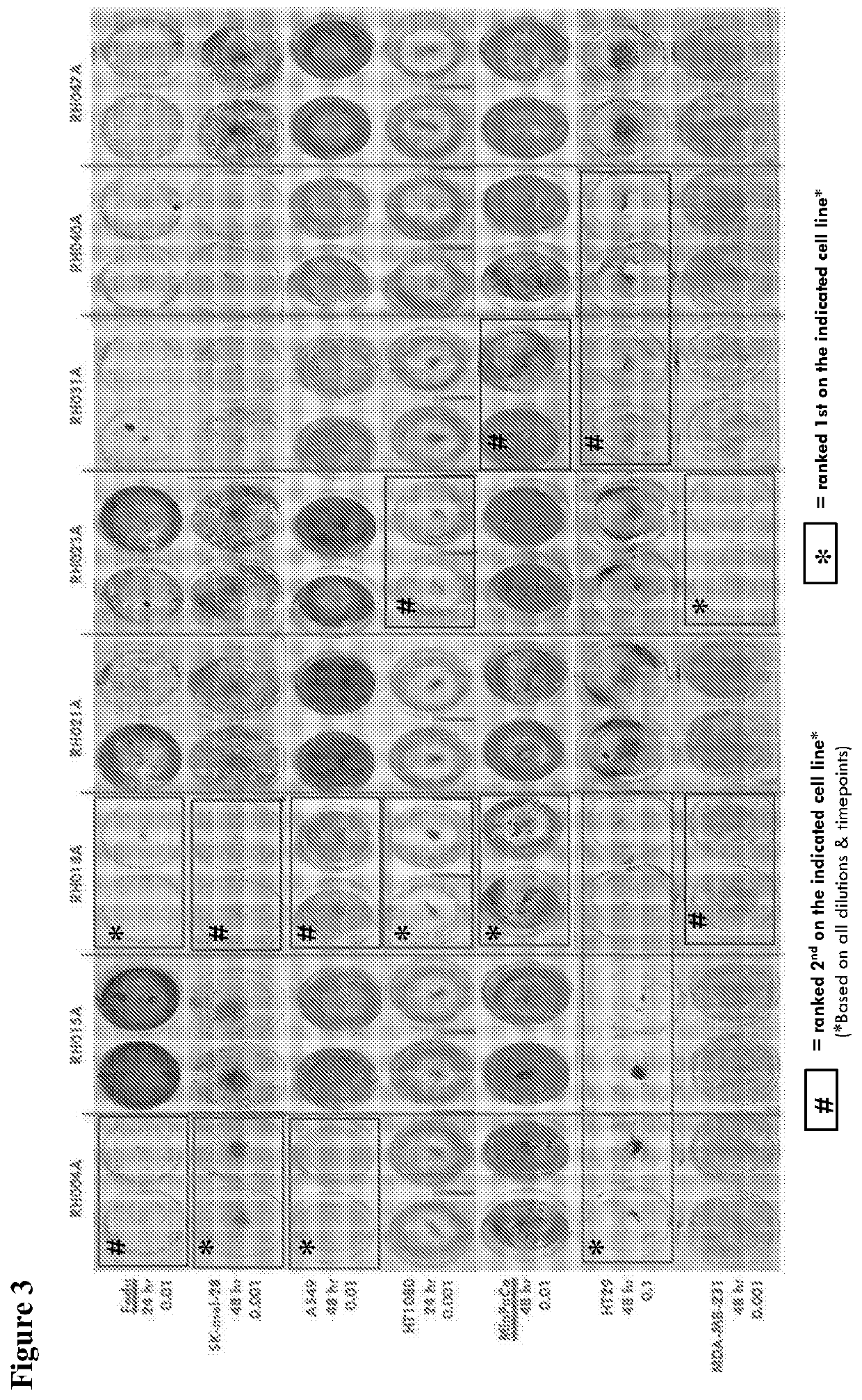Treatment using oncolytic virus
a technology of oncolytic virus and immunotherapy, which is applied in the direction of viral antigen ingredients, biochemistry apparatus and processes, pharmaceutical non-active ingredients, etc., can solve the problems of not all patients achieve a survival advantage, and not all tumors respond to treatment. , to achieve the effect of improving systemic anti-tumor immune effects, and improving direct oncolytic effects
- Summary
- Abstract
- Description
- Claims
- Application Information
AI Technical Summary
Benefits of technology
Problems solved by technology
Method used
Image
Examples
example 1
Isolates with Improved Anti-Tumor Effects
[0260]The virus species used to exemplify the invention is HSV, specifically HSV1. Cold sore swabs were taken from more than 20 otherwise healthy volunteers. A sample of each swab was used to infect BHK cells. Samples containing HSV1 were identified by the presence of a cytopathic effect (CPE) 24-72 hours post infection and by immunohistochemistry and viral stocks of the primary clinical isolates were generated from the positive samples.
[0261]The abilities of the primary clinical isolates of HSV1 to kill a panel of human tumor-derived cell lines is tested and the virus strain with the greatest ability to kill a broad range of these rapidly, and at low dose is chosen. Tumor cell lines used for this comparison are HT29 (colorectal), MDA-MB-231 (breast), SK-MEL-28 (melanoma), Fadu (squamous cell carcinoma), MCF7 (breast), A549 (lung), MIAPACA-2 (pancreas), CAPAN-1 (pancreas), HT1080 (fibrosarcoma). The cell lines are used to test for the level o...
example 2
ion of Clinical Isolates
[0264]In this example the clinical isolate selected in Example 1 is modified by deletion of ICP47 from the viral genome using homologous recombination with a plasmid containing regions flanking HSV1 nucleotides 145300 to 145582 (HSV1 nucleotides 145300 to 145582 being the sequences to be deleted; HSV1 strain 17 sequence Genbank file NC 001806.2) between which are encoded GFP. GFP expressing virus plaques are selected, and GFP then removed by homologous recombination with the empty flanking regions and plaques which do not express GFP are selected. This results in an ICP47 deleted virus in which US11 is expressed as an IE protein as it is now under the control of the ICP47 promoter. ICP34.5 is then deleted using homologous recombination with a plasmid containing regions flanking HSV1 nucleotides 124953 to 125727 (HSV1 nucleotides 124953 to 125727 being the sequences to be deleted; HSV1 strain 17 sequence Genbank file NC 001806.2) between which GFP is encoded. ...
example 3
n of Two Immune Stimulatory Molecule from a Virus Expressing a Fusogenic Protein
[0269]A virus similar to the GALV-R− and mGM-CSF expressing virus described above is constructed, but additionally expressing versions of CD40L. Here, instead of using a plasmid containing ICP34.5 flanking regions and an expression cassette comprising GM-CSF and GALV-R− driven by a CMV and an RSV promoter, a plasmid containing ICP34.5 flanking regions and an expression cassette comprising GM-CSF. GALV and CD40L driven by a CMV, an RSV and an SV40 promoter is used for recombination with the virus containing GFP inserted into ICP34.5 and non-GFP expressing plaques again selected.
[0270]In more detail, deletion of ICP47 from the viral genome using homologous recombination with a plasmid containing regions flanking HSV1 nucleotides 145300 to 145582 (HSV1 nucleotides 145300 to 145582 being the sequences to be deleted; HSV1 strain 17 sequence Genbank file NC_001806.2) between which are encoded GFP. GFP expressi...
PUM
| Property | Measurement | Unit |
|---|---|---|
| time | aaaaa | aaaaa |
| time | aaaaa | aaaaa |
| time | aaaaa | aaaaa |
Abstract
Description
Claims
Application Information
 Login to View More
Login to View More - R&D
- Intellectual Property
- Life Sciences
- Materials
- Tech Scout
- Unparalleled Data Quality
- Higher Quality Content
- 60% Fewer Hallucinations
Browse by: Latest US Patents, China's latest patents, Technical Efficacy Thesaurus, Application Domain, Technology Topic, Popular Technical Reports.
© 2025 PatSnap. All rights reserved.Legal|Privacy policy|Modern Slavery Act Transparency Statement|Sitemap|About US| Contact US: help@patsnap.com



